Outstanding Portfolio Guide
- Transfer
- Tutorial
In UX design, portfolios mean more than higher education. Employers and recruitment managers will use your portfolio to determine your experience, aesthetics and, more importantly, your ability to solve business problems in the real world.
Creating your first portfolio can seem like an incredibly difficult task. I put together a comprehensive guide to help novice UX designers create a portfolio that shows their unique stories.
This is an obvious step in creating a good online portfolio. Your site, this is not an easy description of your work - this is your work. Do your best to make it perfect.
Add Google Analytics to your site to collect traffic statistics. This will help you to compile a profile of your visitors: who recently visited your site (location), how long and what your projects he looked through. Using this data, you can optimize the performance of your site to the maximum.
Do not experiment and do everything wisely. Make sure that users know exactly how to know more about you: a page about you, portfolio, contacts, etc.

Despite the fact that the Tiffany site contains many interesting cases, it’s difficult to find actual navigation.
Your portfolio should not be limited to one site. Behance and Dribbble are great places to share your work. This will help you find future clients and employers, and will also add to your prestige among designers.

Behance plays an important role in finding new customers for many companies. In Ramotion one of my favorite portfolio. Almost every of their work receives a lot of attention from the media.
Make sure your portfolio is centered around the user. Determine what your audience wants to see and show how your skills can come in handy.
Next, you need to identify your strengths and focus on them in your portfolio. Finding answers to the following questions will help you better present yourself:
Your main page should briefly but effectively tell you who you are and what kind of work you are looking for. Give visitors a quick summary before they see the About Me page.

Adham's homepage shows his skills well.
The About Me page is the best place to tell more about your experience, your hobbies, interests, and who you would like to become. Use it to let your future employers understand who you are as a person.

Eric Bew's portfolio is a great combination of sleek design and a memorable personality.
Social proof of your skills is a good way to build trust on any site, but they are especially good for a portfolio. Reviews are easy enough to collect if you have a good relationship with customers.

Edmund highlighted a whole page for reviews.
UX Unicorn is a ghostly designer who has many skills in all areas of design. Instead, think of your skills as a T-figure . The “T-shape" concept means that there are some skills that you must have in order to consider yourself a professional (horizontal line), and there are other skills that you own (vertical line).
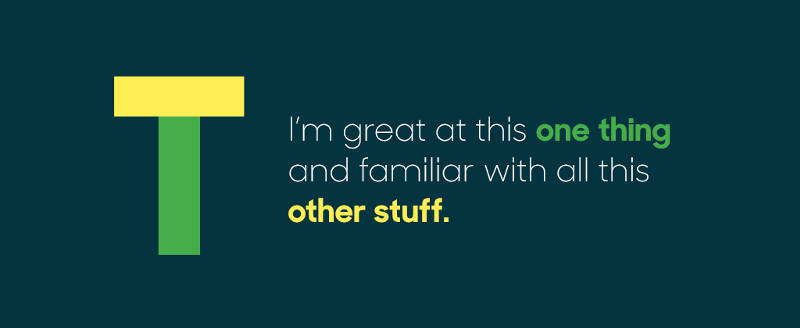
(I am very good at this and am well acquainted with this other - approx. Per.) Image: Futurice
It is very tempting for better competitiveness to indicate that you are good at everything, but you should avoid this thought. Instead, focus on your core skills and use your experience to convey why they are so important.
Despite your approach and the aesthetics of your site, most employers want to know how you solve problems. Spend some time thinking about how you will present your projects to maximize their value.
Let your most impressive projects be displayed first, instead of in chronological order. This is especially important if you have little experience and want to get your first job at UX. Keep in mind that your portfolio should not only show your past work, but also indicate the direction of development. Make sure that you add to the portfolio only the type of projects that you want to work with more.
The initial stages of candidate selection can be ruthless. A recruiting manager or employer should review dozens (if not hundreds) of portfolios to select a few. Do not be surprised that they often make decisions in less than a minute. Troy Park and Patrick Neeman claim that people spend about 10-15 seconds looking at the UX portfolio. Try to briefly convey project details using text and check if basic information is available on your site using a 60-second test . Alan Shen
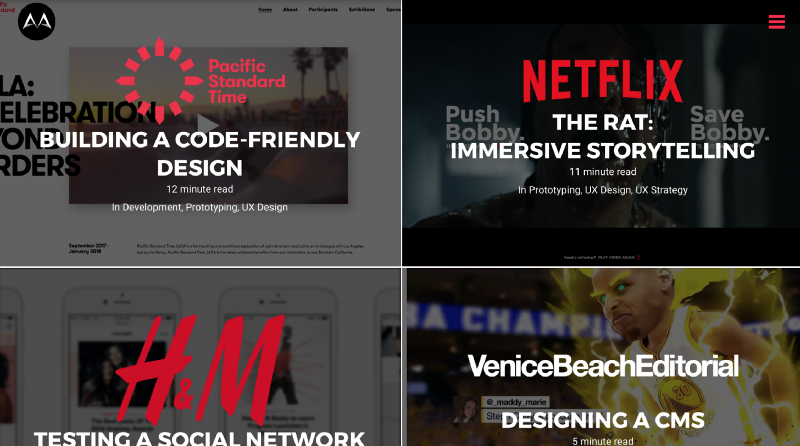
's portfolio has a good preview for each project.
For many designers, the NDA is the greatest threat to their portfolio. Nevertheless, the NDA should not be the reason to exclude the project from the portfolio. Here are some ways to solve the problem with the NDA:
All recent graduates have the same problem - they cannot get work experience without a portfolio, and they cannot get a portfolio without work experience. I recommend showing your potential in any way possible. For example, you can participate in the Daily UI Challenge and add some of the best to your portfolio. DailyUI (99designs also works well - approx. Per.) Is especially good for beginners, because it not only helps to develop your skills, but also makes you more visible in the design community. Additionally, I recommend adding academic work and concept projects to the portfolio.
Less is better for your portfolio. Select 2 or 3 projects and describe them in detail. Exclude projects too similar to each other, one story will be enough. It would be normal to have a portfolio of just one project, if it is a good project.
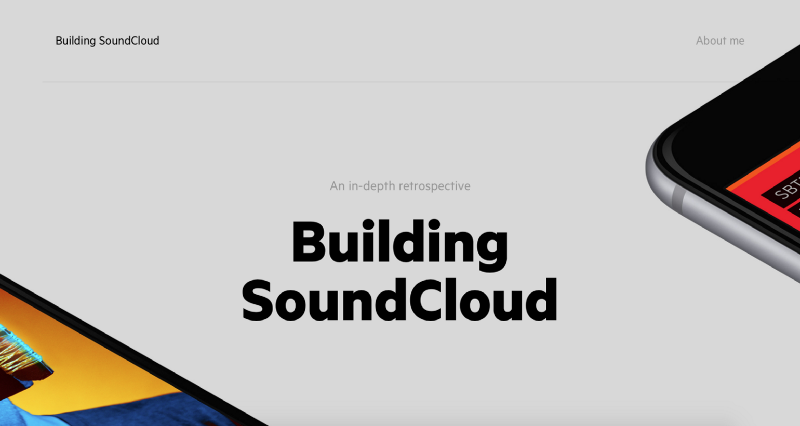
The entire portfolio of Michael Everson is built around one project - SoundCloud for iOS. He describes in detail all the stages of development and supports them with excellent previews, so he makes it clear how it works.
While in other industries it will be enough to show only the final product or describe the results, in UX everything is different. More than just seeing the finished product, employers / customers want to know how you solved the problem. It is very important to show what process your work went through and that it did not just appear as if by magic. Although the description format may vary depending on the project, basically, I recommend dividing each project into two stages: review and UX process. First comes the review. The visitor should be able to immediately understand what this project is about and its goals. Here are the topics you can add:
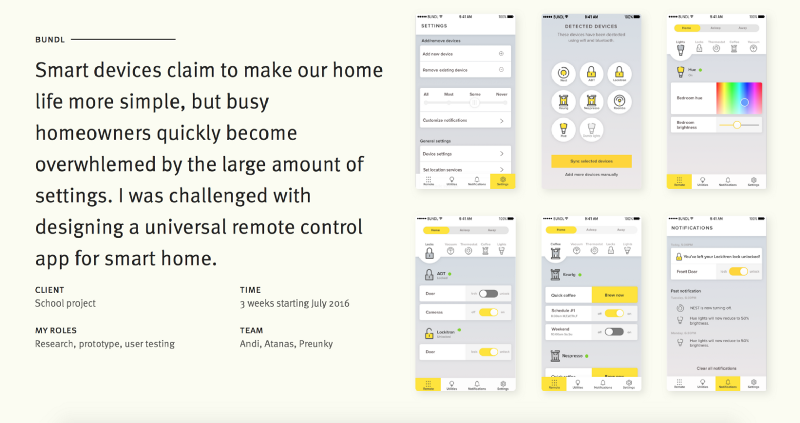
Each work from Itun Zhang's portfolio begins with a brief overview.
The UX process phase is perhaps the most important part of your portfolio. As a UX designer, you must take the explanation of the whole process very seriously, as you will be evaluated on it.

An example of a UX process. Image: Zurb .
You must understand that your work can only be evaluated in context. Describe the problem and its solution, show the process that you went through to get the final product.
Your projects are a story about you and your projects, a story about your journey, your successes and problems, your obstacles on the way.
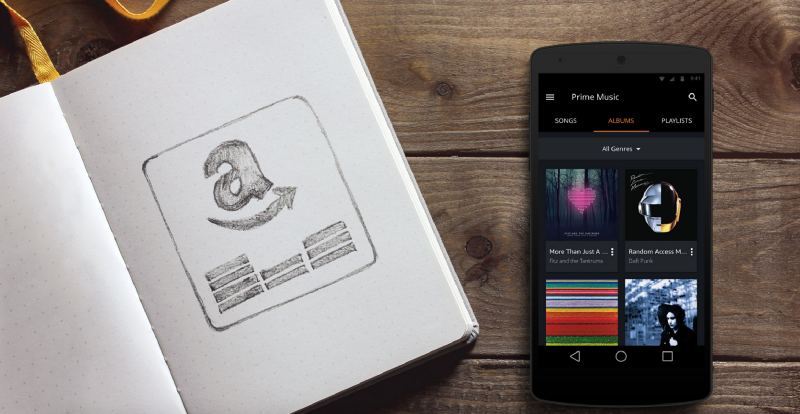
Simon Pen presents each piece of design as a separate story, complemented by excellent images. Amazon Prime Music development history from Simon's portfolio.
Show the value that you brought to the company that hired you. If possible, describe how your design led the company to success. If there are positive results, be sure to tell about them: emphasize why the project was successful (target metrics rose by X%) and strengthen your role in achieving it.
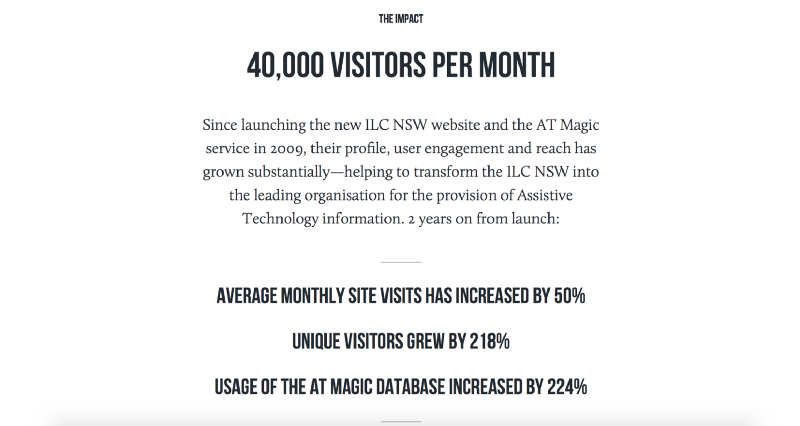
Another example from Simon's portfolio. Result of the ILC NSW 'AT Magic' project
Do not pretend that you are a visual designer (unless you are). Remember, the goal of a portfolio is not to show your amazing design skills. The presence of competent visual design skills will definitely be a plus, but do not confuse them with the main task of your position - “solving business problems by developing interaction experience”.

Portfolio Glory Kim pays too much attention to images and does not provide basic information about the UX process.
Quite often, UX designers in their portfolios concentrate on the final product, rather than the “journey” of the project. However, hiring managers are less interested in the final product; they are more interested in the process of creating these products. A good portfolio is always complemented by research behind the final result.

Michael Shchepansky presents each part as an exciting story that emphasizes his insight.
Do not lie. It is easy to appropriate all the merits for a project that a whole team worked on. Remember, honesty is the best strategy: if you don’t know how to do something or you don’t have experience with this, do not talk about it in your portfolio! Clearly and honestly outline your role and those who have worked with you.
Creating a good UX portfolio is a journey that requires a lot of effort (time, training, and repetition), but it is definitely worth it. If you succeed, the portfolio will demonstrate the depth of your abilities as a designer, show how you think and give potential employers or clients an understanding of what it is to work with you. Remember, people hire people, not a portfolio.
Creating your first portfolio can seem like an incredibly difficult task. I put together a comprehensive guide to help novice UX designers create a portfolio that shows their unique stories.
1. Create a website
This is an obvious step in creating a good online portfolio. Your site, this is not an easy description of your work - this is your work. Do your best to make it perfect.
1.1 Connect web analytics
Add Google Analytics to your site to collect traffic statistics. This will help you to compile a profile of your visitors: who recently visited your site (location), how long and what your projects he looked through. Using this data, you can optimize the performance of your site to the maximum.
1.2 Make your navigation as clear as possible.
Do not experiment and do everything wisely. Make sure that users know exactly how to know more about you: a page about you, portfolio, contacts, etc.

Despite the fact that the Tiffany site contains many interesting cases, it’s difficult to find actual navigation.
1.3 Create additional portfolios on other sites
Your portfolio should not be limited to one site. Behance and Dribbble are great places to share your work. This will help you find future clients and employers, and will also add to your prestige among designers.

Behance plays an important role in finding new customers for many companies. In Ramotion one of my favorite portfolio. Almost every of their work receives a lot of attention from the media.
2. Tell a story
Make sure your portfolio is centered around the user. Determine what your audience wants to see and show how your skills can come in handy.
- Search and analyze vacancies. This will help you understand what skills, education and experience are needed for the job you want.
- Find those with whom you are competing. Browse their portfolio to determine where you can stand out.
Next, you need to identify your strengths and focus on them in your portfolio. Finding answers to the following questions will help you better present yourself:
- What is your training? What skills will be most useful for the UX designer?
- Do you have a certain style? Do you specialize in specific types of design?
2.1 Create a nice homepage and About me page
Your main page should briefly but effectively tell you who you are and what kind of work you are looking for. Give visitors a quick summary before they see the About Me page.

Adham's homepage shows his skills well.
The About Me page is the best place to tell more about your experience, your hobbies, interests, and who you would like to become. Use it to let your future employers understand who you are as a person.

Eric Bew's portfolio is a great combination of sleek design and a memorable personality.
2.2 Use reviews
Social proof of your skills is a good way to build trust on any site, but they are especially good for a portfolio. Reviews are easy enough to collect if you have a good relationship with customers.

Edmund highlighted a whole page for reviews.
2.3 Do not try to be a UX unicorn
UX Unicorn is a ghostly designer who has many skills in all areas of design. Instead, think of your skills as a T-figure . The “T-shape" concept means that there are some skills that you must have in order to consider yourself a professional (horizontal line), and there are other skills that you own (vertical line).

(I am very good at this and am well acquainted with this other - approx. Per.) Image: Futurice
It is very tempting for better competitiveness to indicate that you are good at everything, but you should avoid this thought. Instead, focus on your core skills and use your experience to convey why they are so important.
3. Think about how to structure your projects there.
Despite your approach and the aesthetics of your site, most employers want to know how you solve problems. Spend some time thinking about how you will present your projects to maximize their value.
3.1 Arrange the most suitable projects first (instead of the last)
Let your most impressive projects be displayed first, instead of in chronological order. This is especially important if you have little experience and want to get your first job at UX. Keep in mind that your portfolio should not only show your past work, but also indicate the direction of development. Make sure that you add to the portfolio only the type of projects that you want to work with more.
3.2 Create a promising preview
The initial stages of candidate selection can be ruthless. A recruiting manager or employer should review dozens (if not hundreds) of portfolios to select a few. Do not be surprised that they often make decisions in less than a minute. Troy Park and Patrick Neeman claim that people spend about 10-15 seconds looking at the UX portfolio. Try to briefly convey project details using text and check if basic information is available on your site using a 60-second test . Alan Shen

's portfolio has a good preview for each project.
3.3 Overcome the NDA (non-disclosure agreement)
For many designers, the NDA is the greatest threat to their portfolio. Nevertheless, the NDA should not be the reason to exclude the project from the portfolio. Here are some ways to solve the problem with the NDA:
- Ask for permission. If you have a good relationship with the client, you may be allowed to publish the project, especially if you remove all sensitive details.
- Depersonalize the work. Do not provide specific information and use blur to hide elements that are suggestive to the client. A potential employer will be more interested in seeing the big picture (what you can do) than certain details of another company.
- Recreating. If you cannot show the real project, recreate it to show what you have done. Just remember to indicate that this is a recreated work.
3.4 Just Don't Say You Don't Have Portfolio Projects
All recent graduates have the same problem - they cannot get work experience without a portfolio, and they cannot get a portfolio without work experience. I recommend showing your potential in any way possible. For example, you can participate in the Daily UI Challenge and add some of the best to your portfolio. DailyUI (99designs also works well - approx. Per.) Is especially good for beginners, because it not only helps to develop your skills, but also makes you more visible in the design community. Additionally, I recommend adding academic work and concept projects to the portfolio.
3.5 Focus on quality instead of quantity
Less is better for your portfolio. Select 2 or 3 projects and describe them in detail. Exclude projects too similar to each other, one story will be enough. It would be normal to have a portfolio of just one project, if it is a good project.

The entire portfolio of Michael Everson is built around one project - SoundCloud for iOS. He describes in detail all the stages of development and supports them with excellent previews, so he makes it clear how it works.
4. Describe in detail
While in other industries it will be enough to show only the final product or describe the results, in UX everything is different. More than just seeing the finished product, employers / customers want to know how you solved the problem. It is very important to show what process your work went through and that it did not just appear as if by magic. Although the description format may vary depending on the project, basically, I recommend dividing each project into two stages: review and UX process. First comes the review. The visitor should be able to immediately understand what this project is about and its goals. Here are the topics you can add:
- Project Objectives - Why was the project launched?
- Goal - What results do you need to get?
- Duration - How much time was spent?
- Team - Who did you work with on the project? Add names and links to their LinkedIn profiles.
- Your role - What contribution did you make to the project?
- Result - Images / videos or links to download the application, view the prototype, source codes.

Each work from Itun Zhang's portfolio begins with a brief overview.
The UX process phase is perhaps the most important part of your portfolio. As a UX designer, you must take the explanation of the whole process very seriously, as you will be evaluated on it.

An example of a UX process. Image: Zurb .
You must understand that your work can only be evaluated in context. Describe the problem and its solution, show the process that you went through to get the final product.
- Problem / challenge in design - It can be something simple, for example, a few suggestions that will tell about the problem (business) that you were solving.
- User Audience Research - Describe your users and their needs, motivation and problem areas. This part may include the tools with which you collected this information (for example, characters and sympathy cards ). You can also mention the analysis of competitors (consider the strengths and weaknesses of competitors in solving the needs of users).
- Solution - In this part, answer the following questions: How did you solve the problem? Why did you choose this solution and what influenced your choice?
- Design - Be sure to describe how you went from ideas to a specific solution. Show the flowcharts, layouts and working prototypes (yes, these are all different things - approx. Per.). Employers should know that you can do this and can look at the project from the point of view of the developer. If possible, add an interactive prototype (such as InVision ) to allow visitors to play with it.
- Testing - How do you measure success / failure? How did you test your solution? What questions did you ask?
4.1 Create a strong story
Your projects are a story about you and your projects, a story about your journey, your successes and problems, your obstacles on the way.
- Define priorities for different information about your project and give it to readers in the right place to make the story more interesting.
- Show off your problem solving skills. Describing the different parts of your work in the portfolio, make sure that you clearly talked about the problem that was and how you solved it.
- Demonstrate your ability to use the right tools to solve the problem.
- Show your ability to express yourself concisely with words and images. Explain the process step by step and give the images context.
- Try to clearly show what you learned while working on the project.

Simon Pen presents each piece of design as a separate story, complemented by excellent images. Amazon Prime Music development history from Simon's portfolio.
4.2 Describe the impact of your work
Show the value that you brought to the company that hired you. If possible, describe how your design led the company to success. If there are positive results, be sure to tell about them: emphasize why the project was successful (target metrics rose by X%) and strengthen your role in achieving it.

Another example from Simon's portfolio. Result of the ILC NSW 'AT Magic' project
4.3 Do not go in cycles in visual representation
Do not pretend that you are a visual designer (unless you are). Remember, the goal of a portfolio is not to show your amazing design skills. The presence of competent visual design skills will definitely be a plus, but do not confuse them with the main task of your position - “solving business problems by developing interaction experience”.

Portfolio Glory Kim pays too much attention to images and does not provide basic information about the UX process.
4.4 Do not focus only on the ultimate goal
Quite often, UX designers in their portfolios concentrate on the final product, rather than the “journey” of the project. However, hiring managers are less interested in the final product; they are more interested in the process of creating these products. A good portfolio is always complemented by research behind the final result.

Michael Shchepansky presents each part as an exciting story that emphasizes his insight.
4.5 Do not overestimate your contribution
Do not lie. It is easy to appropriate all the merits for a project that a whole team worked on. Remember, honesty is the best strategy: if you don’t know how to do something or you don’t have experience with this, do not talk about it in your portfolio! Clearly and honestly outline your role and those who have worked with you.
Conclusion
Creating a good UX portfolio is a journey that requires a lot of effort (time, training, and repetition), but it is definitely worth it. If you succeed, the portfolio will demonstrate the depth of your abilities as a designer, show how you think and give potential employers or clients an understanding of what it is to work with you. Remember, people hire people, not a portfolio.
